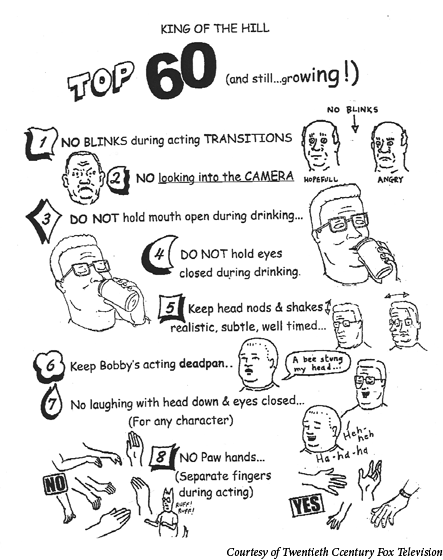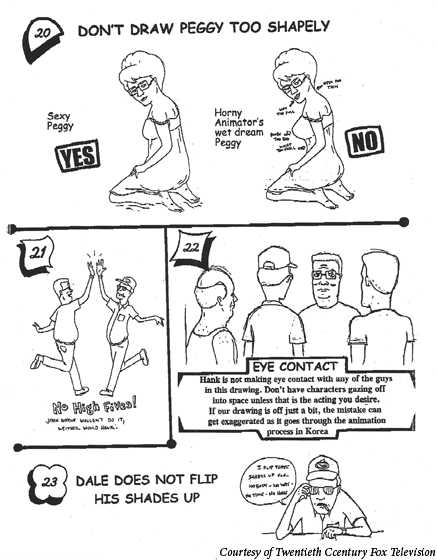Long Live the King
Archives of a cult classic are open for all to judge.
Punctuated by chiming, infectious laughter, it was an otherwise serious affair that brought several hundred people to a conference on the seventh floor of the Alkek Library at Texas State University-San Marcos one breezy evening last month.
Jim Dauterive, writer and executive producer of the cult animated television sitcom “King of the Hill,” was the guest speaker, and-most of the time anyway-was ready for the avalanche of questions hurled at him by fans, students, and teachers who clearly have spent too much time thinking about the show.
Whom would Hank Hill vote for?
Hank Hill would never tell you.
What’s Hank’s favorite movie?
Of course it would be “Lonesome Dove,” followed by “Patton” and “National Lampoon’s Family Vacation.”
Will Bobby ever grow up?
No, he’s going to remain sweet and slothful and forever in the eighth grade.
Do you like making Peggy suffer (last seen, she was falling out of a plane)?
The woman just makes good comedy, but OK, occasionally writers go too far.
What are you telling the rest of the nation about Texas, and do people get it?
Unlike, say, “Dallas,” “King of the Hill” is written through the eyes of working-class Texans and middle-Americans, so yes, a majority do get it.
“I’ve heard people in Texas call it a documentary,” said Dauterive, a Dallasite. “If you live in New York, you might think it’s anthropology.”
The savvy exchange on Nov. 11 lasted three hours, and the questions kept coming. One last question-a statement, really-from a professor in the English Department stumped Dauterive:
“‘King of the Hill’ is urban globalization … but contextually is it like ‘Mad Men’ or ‘The Sopranos?'”
“Oh man,” answered Dauterive. “You’re talking academic.”
But the Texas State conference was indeed celebrating the hoisting of “King of the Hill” to academic eminence: Dauterive has donated boxes of archives documenting 11 years of behind-the scenes, madcap writing and production for student research.
“For young people who want to be writers, it’s a way to see it is possible. It shows the hard work involved, including all the many false starts, discarded ideas-and a lot of bad writing too,” Dauterive said. “You give yourself permission to be bad and keep writing until it’s good. You can see that process here.”
Dauterive began bequeathing his work in 1999, but when “King of the Hill” seemed to hit the end of its run after 10 seasons in 2005, he began shipping boxes of the show’s material to the university in earnest.
“Essentially, the show was canceled, and our writers took other jobs. I thought it was going to the underground salt mines of Nebraska, a fate the show didn’t deserve, being a cultural touchstone for Texas in a particular point in time,” he said. The show has survived a bit longer than Dauterive expected. His donated materials form a treasure trove for fans and researchers who want to understand a bit more about Texas, and how a simple animated show captured the state’s character as well, or better, than scores of others that have tried.
Much of the bequest was exhibited from Sept. 1 through Dec. 14 at the Alkek Library, where the prestigious Wittliff Gallery of Southwestern & Mexican Photography also showcases the making of another fabled Texas televised saga: “Lonesome Dove.”
“This is what I pay good money for to come to college. Thanks a million!” one student wrote on the ledger after admiring the Hill exhibit. It’s arranged into seven parts from episodes, production materials, marketing ideas, photographs, drawings, artifacts, and guide books that were drafted to outline the show’s general principles and keep writers from veering off course.

The guide books include The Death of Common Sense, billed as the basis for Hank’s common-sense philosophy, and The Book of Virtues, which inspires Peggy’s know-it-all ponderings.
There are also imagined “interview questions” reporters might pose to the characters, asking about the intricacies of selling propane, of sentimental relationships, and of world politics. (In 1997, Texas Monthly named Hank Hill one of the “Texas Twenty”-one of “the most impressive, intriguing and influential Texans” of the year.)
“King of the Hill” was the brainchild of writer Mike Judge, now a mercurial Austinite who created the MTV hit series “Beavis and Butthead.” Judge partnered with Greg Daniels, a writer for “The Simpsons,” which also airs on Fox.
Neither Judge nor Daniels, who now directs the hit show “The Office,” was at the exhibit’s reception and conference. “Again, I apologize for not being Mike Judge,” Dauterive repeatedly told the audience.
Judge is credited with the relatively simple concept of giving a well-intentioned, befuddled propane salesman in a Texas suburb the panache to reach across audiences, from young to old, and across racial and religious lines.
“Mike Judge is the ultimate hip guy, and he chose to do a neighborhood family show,” said Hill collection curator Connie Todd. “It’s a pedestrian setting like “All in the Family” or “The Office” that everyone relates to.”
Dauterive said Judge came up with the idea of life on Rainey Lane when he was living in Richardson, Texas, and having trouble with his fence. Hammering away in an alley, his pounding was the siren’s call to a motley assemblage of curious, beer-swigging neighbors who offered a hand.
Before Judge knew it, his neighbors had taken over, and it was Judge who was standing there with a beer in his hand, watching the fence-mending.
“It was one of those moments that make things click,” Dauterive said.
Hank was born, a Dallas Cowboy fanatic with a narrow urethra who loves his wife Peggy, a substitute Spanish teacher who never suffers from a lack of self confidence.
Enter their son Bobby, a chubby, deadpan 12-year-old who doesn’t live up to Hank’s idea of a good son, who’s not interested in football or the male haven of shop class.
Hank’s anxiety over Bobby provides ongoing fodder for an early line of the sitcom, “the boy ain’t right.”

In the Hills’ urban Texas cosmos, there’s also Hank’s brash father Cotton, the World War II veteran who brags his shins were shot out in a Japanese POW camp; neighbors Dale, an exterminator; Boomhauer, a muffled-voiced ladies’ man; Bill, the melancholic divorcee; Luanne, Peggy’s shapely and mindless niece; and Nancy Gribble, a television weather woman who’s married to Dale but is having an affair with native American John Redcorn. Redcorn is Joseph Dribble’s father, though Dale is clueless about it.
While most other sitcoms portray unlikely and atypical events, “King of the Hill” is comedy set in real life as experienced by average Americans.
“Andy Griffith’s back, and he’s pissed … these are good people hampered by political correctness and red tape,” Dauterive said. “There’s a heavy dose of frustration in Hank’s world, and frustration yields comedy.”
Dauterive ventures that Hank Hill could also be compared to the beatified Mother Teresa, who once tried to open a branch of her Missionaries of Charity in New York City but saw her good intentions stymied by bureaucracy.
One document in the archive is known as the “Bible” used by writers to define and understand their characters. On Hank: “He’s a good man in an imperfect world who is loyal to his Arlen employer, Strickland Propane.
“He speaks with authority even if he doesn’t know what he’s talking about.
“At 40, he still doesn’t know much about women, and he’s been married to Peggy for 20 years.
“He’s embarrassed by the site of a few centimeters of someone else’s flesh.
“His heroes include Willie Nelson, Tom Landry, Roger Staubach, Jim Bowie, and Sam Houston.
“His best friends may be idiots, but at least they live close by.
“He likes beer, ‘which is about the same as saying he likes to breathe.'”
As for Peggy:
“She is strong and independent, as in Ann Richards, but stands by her man.
“She was a great high school beauty, speaks Spanish with a strong Texas accent, and her dog Ladybird only understands commands in Spanish.
“She’s the Boggle champion of Texas and is working on a novel in her laundry room on an antiquated Kaypro typewriter.”
Most of the action takes place on one block in Arlen, “where the most prominent features of the landscape are pickup trucks, motorboats, and riding mowers way too big for the lawns they serve.”
It’s typical of the ‘burbs surrounding Texas cities-think Garland and Mesquite around Dallas, or Humble outside Houston.
“It used to be a small town with a main street, stoplight and courthouse,” the sitcom’s “Bible” adds. “But with the oil boom in the late ’60s and ’70s, the big city began to swallow it up and litter it with lumberyards, car dealerships, convenience stores, and cookie-cutter tract housing.”
The archives reveal how the show’s writers-with the aid of Judge, Dauterive, and Austin’s Johnny Hardwick, who can explain such things-handled such challenges as explaining to a mystified international television audience (including Mexicans and Japanese) what exactly constitutes a chicken-fried steak, at what age a Texas boy can be expected to acquire his first gun, and not least, how many people Charles Whitman shot from the Texas Tower.
The simple art of drawing the characters also has rules that make the show distinct from other animated sitcoms. There are 60 rules “and growing.” Among them:
-No looking into the camera.
-Do not hold mouth open during drinking.
-Do not hold eyes closed while drinking.
-Don’t draw Peggy too sexy.
-Dale does not flip his shades up.
-No big horse teeth.
-No desert cacti tumbleweed shots-wrong for this part of Texas.
-Animals don’t act human.
“We also get our ideas from the Internet, yawn, and by reading Texas publications like Texas Monthly, the big city papers, and small-town stuff like the Pflugerville Flag and the Johnson City Record Courier,” the show’s writers note. “We read The Onion, too, because we think it’s funny.”
Because it’s funny-and because Dauterive says it’s a “comfy, old chair”-“King of the Hill” is back for another season despite threats of annihilation.
“I don’t know if this show could be pitched now. It’s so crude, so unanimated. It shows the world passing people by, and they’re trying to hold on to what’s dear,” Dauterive said.
One such holder is Myra Robles, 28, a Texas State graduate now living in Austin. She said “King of the Hill” resonates because, well, they are us.
“King of the Hill is almost a society. We (Texans) are used to making fun of ourselves … in a way that lets everyone know we’re OK with it,” she said. “You either know someone like that, are related to someone like that, or you are someone like that.”
Or live in a world like that. Next season, for example, look for an episode called “Trans Fascism,” in which a turf war evolves outside Strickland Propane between a lunch truck touting a transfat-free lunch and one offering the usual transfat-laden meal.
“It won’t be done in a pompous way,” Dauterive said. “We leave that other stuff to Jon Stewart.”
Susana Hayward is a former reporter for the Associated Press, the San Antonio Express-News, and Knight-Ridder. She lives in San Antonio.


